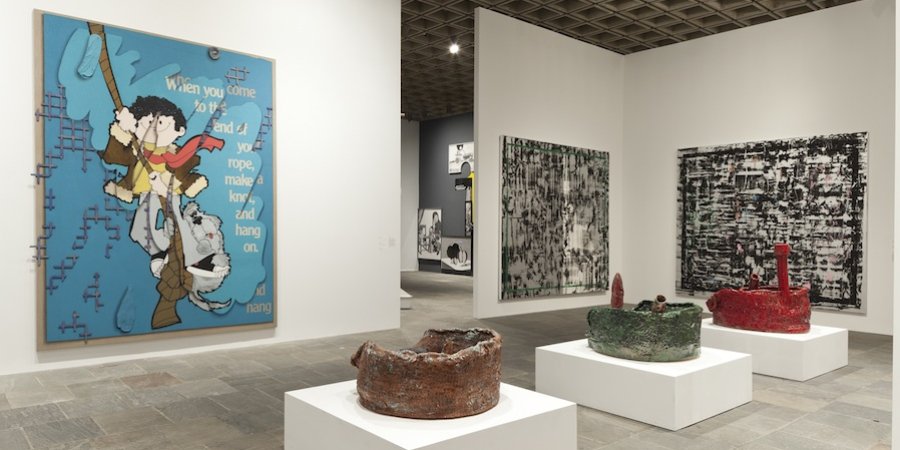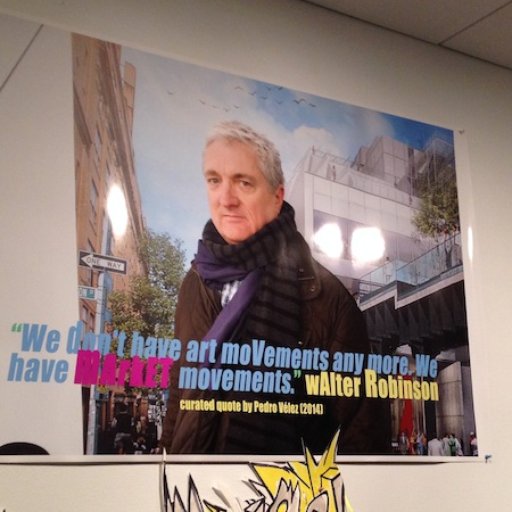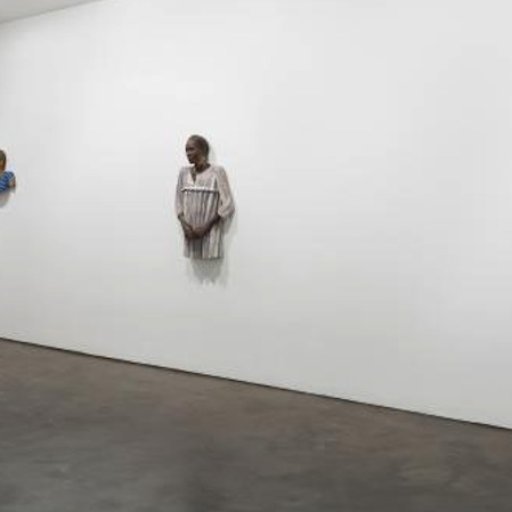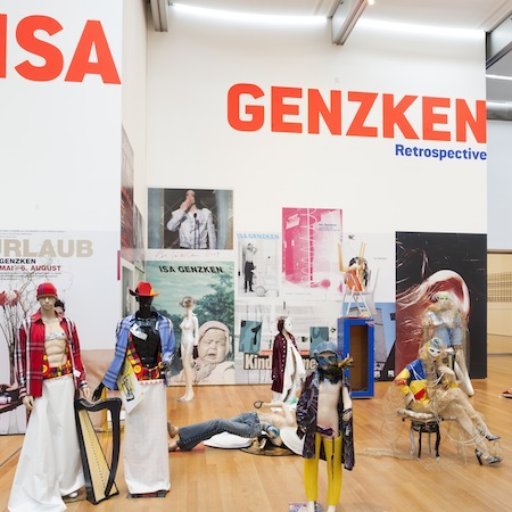New York's art critics have wanted so much from the Whitney Biennial—and they have found it wanting. For a New York Times critic, the show is anodyne, apolitical, and too much like art fairs. For New York magazine, it’s too old, and filled with too much stuff that doesn’t belong. And at the New Yorker, the biennial is frazzled, melancholy, and, despite some occasional visual sumptuousness, strains the patience. More than anything, the consensus seems to be, this show is exhaustingly exhaustive.
Though familiar, all this negativity is a curious thing. It’s almost as if our permissive art-world playpen requires someone to maintain a critical position, and, of course, the critics are there to take on the assignment. But with more than 100 artists spread through four floors, just what does it mean to gauge the exhibition as a whole? Are we judging curatorial vision, artworks, or installation design? Presumably hundreds of hours went into producing the show; how many hours should you spend looking at it? And how many good apples might it take to redeem the whole barrel? Fifty percent? One quarter? Ten? Only one? Considering the question, you can be forgiven for feeling like Lot negotiating with God on the outskirts of Sodom.
Admittedly, this particular biennial comes at a gloomy time. The once-proud show has to compete with bigger biennials, art fairs, and auctions—it's been evident for a decade at least that a museum curator is no match for an art fair’s worth of dealers—and the museum itself is leaving its beloved Breuer building, spiritual home to the biennial and the prior Whitney Annuals, which first launched 82 years ago. The museum’s massive new 21st-century facility, rising like a Leviathan on the Hudson River, is certain to be an avant-garde shrine like no other. Surely, a parochial survey of recent art (mostly from New York) will be out of place there.
In that light, we could go on, critiquing the Whitney for putting up such a quiet, contemplative fight for its final round, and imagining the infinitude of alternative routes it could have taken. If the biennial must be divided into three independent parts, why not make it a real throw-down, like a visual-arts version of those famous Chicago poetry slams? Or, why not give one floor each to Chicago, New York, and Los Angeles and have artists put together shows specifically designed to challenge the others. The passion of battle could give the enterprise some extra juice.
But, walking through the Biennial, it's possible to make out several distinct and interesting currents. One example is a kind of anti-egoism, a self-effacement or sacrifice that can be said to be central to the profession of curating itself—the act of presentation, or re-presentation. As two of the three curators are also artists professionally engaged in showing other artists, so do several of the show's participants present works by their colleagues rather than themselves: Julie Ault installs a “constellation” of works by several people; Joseph Grigely presents an archive left behind by the late critic Gregory Battcock; the Chicago group Public Collectors displays material related to the noise-music fan Malachi Ritscher, who immolated himself to protest the Iraq war; Philip Vanderhyden presents a laboriously reconstructed lost work by the late Pictures Generation artist Gretchen Bender. It’s a special kind of generosity.
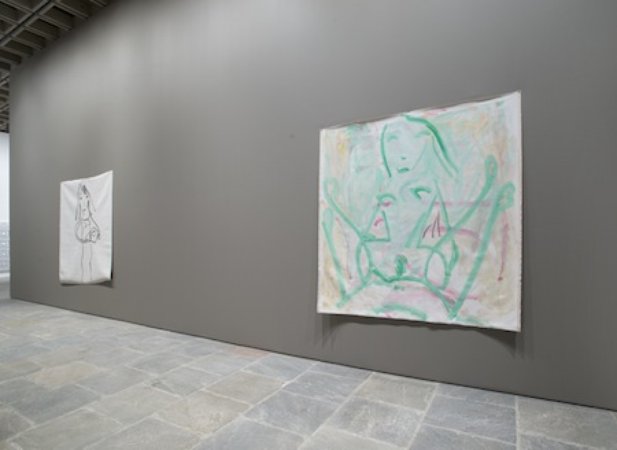 Trevor Shimuzu's untitled and undated paintings displayed on Gaylen Gerber's Backdrop
Trevor Shimuzu's untitled and undated paintings displayed on Gaylen Gerber's Backdrop
The grandest self-effacement of all occurs in the show's prime location, across from the elevators on the museum’s fourth floor, where Gaylen Gerber has installed a large gray painting that exactly resembles the wall on which it hangs. On this most materialist of Minimalist surfaces, Gerber hangs two canvases by Trevor Shimizu, oil paintings of graffiti-like figures of women, one naked and spread-legged, the other carrying a tray like a nurse or waitress. The combination of two artists represents, arguably, a notional history of the picture and the culture that surrounds it, from ancient to modern.
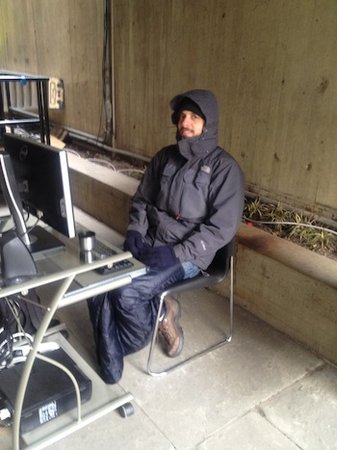
A similar gesture, grandiose and comic, can be found at the opposite end of the exhibition, hidden outdoors in the basement patio behind a concrete pillar. There, the New York artist Diego Lecleryis spending the duration of the exhibition playing the video game Civilization on a desktop computer (and chatting with museum-goers). Unfolding before him over and over, he explains, are endless possibilities of virtual world domination—a metaphor for the real-world goal of art-making. In addition to being a witty coda to Marina Ambramovic's epic 2010 Museum of Modern Art performance, Leclery’s act is perfect theater-as-artwork: a gestalt that can be taken in at a glance rather than the two hours (or two months) that stage performances typically require.
 The collaborative piece by Amy Sillman and Pam Lins
The collaborative piece by Amy Sillman and Pam Lins
A second current, rather less hidden, is an old standby—painting, specifically gestural abstraction—here done by women painters. In addition to its formalist attractions, the biennial’s fourth-floor concentration of "chickstraction" is fun when viewed in the context of gender identity. Is Amy Sillman’s casual geometry feminized by being attached at the hip to a shelf of ceramic pots by Pam Lins? Is Jacqueline Humphries immense, 11-by-12-foot rectangular expanse of undifferentiated patches of silver and black—the colors of much of Warhol’s "Death and Disaster" series, not to mention the notably macho insignia of the Oakland Raiders—an assumption of a masculine perspective?
 Two paintings by Jacqueline Humphries
Two paintings by Jacqueline Humphries
Come to think of it, is there anything at all masculine about the vast chocolate brown and baby blue expanse, and the brightly hued toothy fissures, of the 50-year-old Ab-Ex canvases by Barnett Newman and Clyfford Still that are now on view as part of the Onnasch Collection at Hauser and Wirth in Chelsea?
Every artwork contains within itself an implicit definition of what art is, and one of my favorites in this regard is a 14-foot-tall painting by the Los Angeles artist Laura Owens. The untitled work features an old-fashioned cartoon of a boy and a dog swinging on a rope—an image from a greeting card?—centered atop some stylized free brushwork on a gridded field, an arrangement that suggests the working space on Photoshop. The brushstroke has a painted shadow so it stands out from its ground, a bit of “abstract illusionism” (a now-forgotten type of 1970s Photorealism), and the grid is actually painted wooden lattice attached to the picture surface à la early Pop artworks by Jim Dine and Robert Rauschenberg. In fact, the self-conscious combination of illusion and reality more pointedly recalls T’um (1920), Marcel Duchamp’s final painting, with its famous real safety pins holding shut a trompe l’oeil tear in the surface. Owens’ greeting-card slogan accompanying the cartoon is “When you come to the end of your rope, make a knot, and hang on,” a humorously inspirational slogan that can double as a definition of art’s method and purpose.
In our nutty postmodern world, the 2014 Whitney Biennial can be profitably visited several times—particularly if you remember, when you go, the best part of the show is you looking at it.
(Special thanks to the people who allowed me to consult with them on the biennial, whether they knew it or not, including Sarah Davis, Chris Dorland, Mat Gleason, Tom Otterness, Mary-Louise Schumacher, and John Zinsser.)
Walter Robinson is an art critic who was a contributor to Art in America (1980-1996) and founding editor of Artnet Magazine (1996-2012). He is also a painter whose work has been exhibited at Metro Pictures, Haunch of Venison, Dorian Grey, and other galleries. Click here to see his previous See Here column on Artspace.











